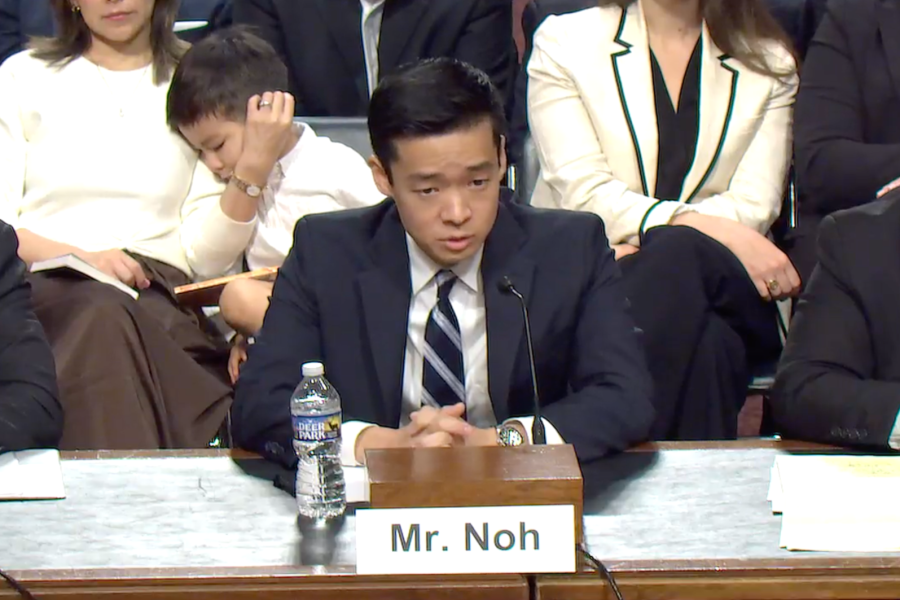The nominee to become the Pentagon’s senior civilian official in charge of the Indo-Pacific testified that allies need to step up their efforts to counter the growing threat of China while stating the U.S. should maintain “combat-credible” forces and strong investments in the region at his Senate confirmation hearing on Oct. 7.
The comments by John Noh, tapped to serve as assistant secretary of Defense for Indo-Pacific security affairs, come amid reports that the Trump administration’s forthcoming National Defense Strategy will focus more on homeland defense instead of countering China, which was the top priority of the 2018 and 2022 strategies.
Asked by Sen. Mark Kelly (D-Ariz.) how he would reaffirm U.S. commitments in the region if the NDS focuses more on the Western Hemisphere, Noh pledged that he “will be the biggest advocate to my leadership in the department for making sure that we have all the resources we need to strengthen deterrence in the Indo-Pacific.”
In written testimony, Noh also said that China “remains our most serious military threat” and is “undergoing an unprecedented and historic military buildup.”
To deter that threat, Noh told lawmakers during the hearing that “first and foremost, we need to ensure that we have combat-credible forces postured forward in the western Pacific with the right capabilities and at the right places. In conjunction, we need to make sure that our allies and partners in the region are doing more, are spending more and are doing their part.”
Noh emphasized the need for combat forces “west of the international dateline” multiple times in his written testimony and also called for the U.S. to “modernize our force posture across the region.”
Those remarks come after the Wall Street Journal reported in May that the Pentagon was considering moving some 4,500 troops out of South Korea and redeploying them across other locations in the Indo-Pacific. In response to written questions about troop withdrawals from the Korean Peninsula, Noh merely said that he would work with U.S. Indo-Pacific Command and U.S. Forces Korea to provide recommendations to senior leadership.
The “right capabilities” that Noh wants for forces in the Indo-Pacific include: “advanced submarine forces; long-range, mobile, precision strike systems; integrated air and missile defense networks; and resilient command and control architectures that can operate effectively within contested environments,” he wrote.
He also noted the importance of investments in fifth-generation aircraft that can survive against China’s anti-access/air denial systems and “unmanned systems in all domains.”
Allies and Partners
Quoting Trump, Noh argued that the administration’s “America First” strategy does not mean “America Alone.” But just as the Trump administration has successfully pushed European allies to invest more of its own resources into defense against the threat of Russia, Noh argued that the U.S.’s Indo-Pacific allies need to step up their game.
Close allies like Japan, South Korea, the Philippines, and Australia need to “significantly increase their own defense investments and take greater responsibility for regional security,” Noh wrote in his testimony.
Some of Noh’s points aligned with the Biden administration’s Indo-Pacific policy as codified in the 2022 National Defense Strategy, which former officials assert was largely an evolution of the first Trump administration’s 2018 NDS. That 2018 document “was a significant turning point, shifting the primary focus of the U.S. military away from counterterrorism … [and] an acknowledgement that the attention and resources devoted to U.S. wars in Iraq and Afghanistan had led to a dangerous erosion of deterrence in the Indo-Pacific,” said Ely Ratner, the Pentagon’s top Indo-Pacific official under the Biden administration, in written testimony to the Senate Foreign Relations Committee pm Oct. 7.
Ratner, who served in the position Noh would assume if confirmed by the Senate, stated that “China seeks to seize Taiwan, control the South China Sea, weaken U.S. alliances, and ultimately dominate the region,” and wants to relegate the U.S. to being a “diminished continental power.”
But allies are a key advantage, Ratner said. “China aims to maximize its coercive pressure by individually isolating regional countries,” he testified. “China’s leaders rightly recognize that different combinations of the United States and its partners can garner sufficient collective power to stymie Beijing’s revisionist aims.”
In his own testimony, Noh told lawmakers that Taiwan “absolutely needs to do its part and spend more and increase its defense spending and acquire the kind of asymmetric capabilities that will be most relevant for an invasion scenario” by China.
The Pentagon has launched a review of its “AUKUS” security initiative with Australia and the United Kingdom focused in part on developing nuclear-powered submarines. Noh called the review a “brass tacks, common sense” look at whether the project could be more “sustainable,” and under questioning from multiple senators said it would likely be completed this fall.
On an operational level, Noh said in his written testimony that he supported efforts to increase cooperation with allies in the South China Sea, including the Philippines, Australia, and Japan. Those efforts have included air and maritime patrols, information sharing, and more.


